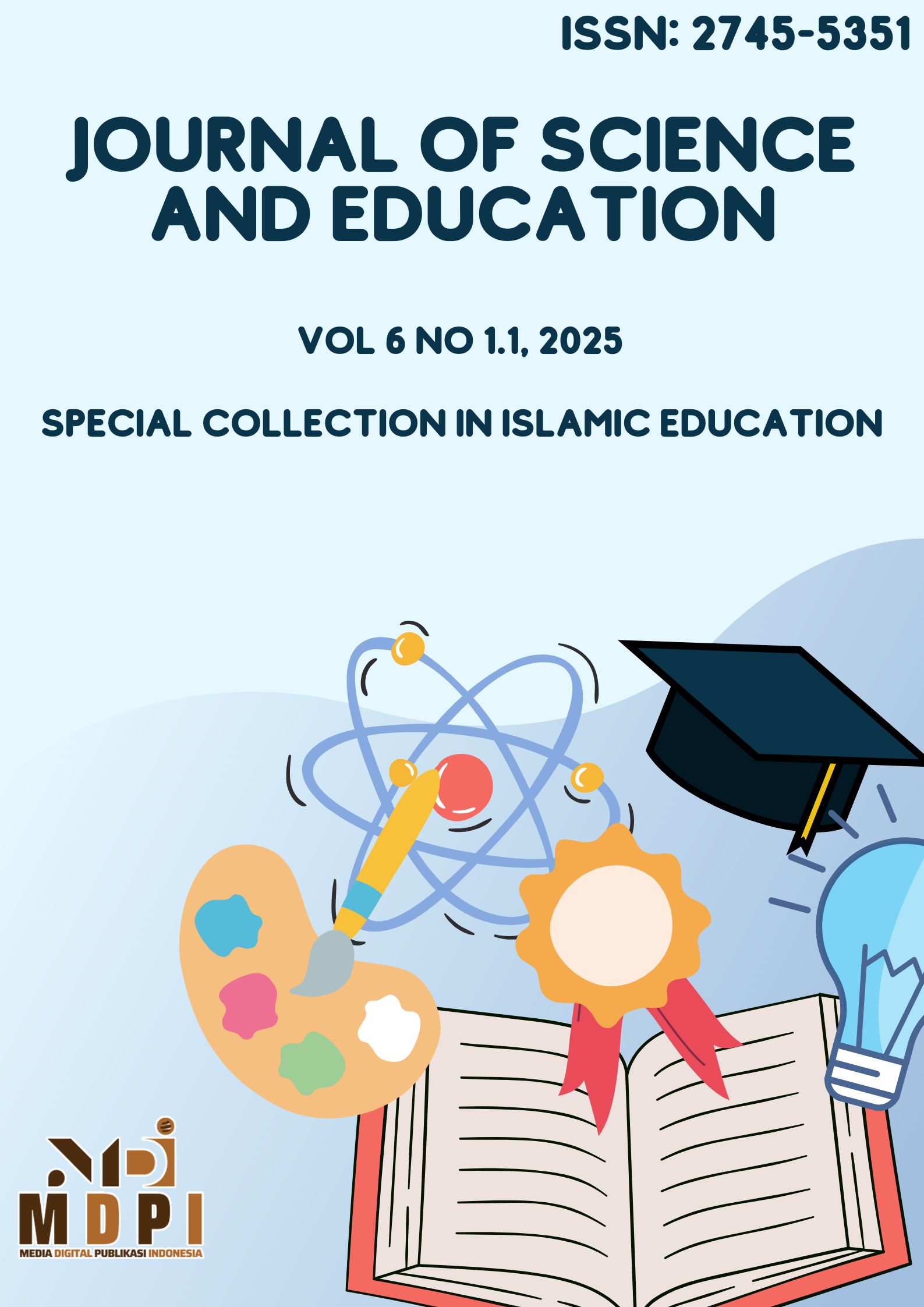The Role of Islamic Education Teachers in Forming Religious Character of Students Through Extracurricular Pesantren Kilat Activities
DOI:
https://doi.org/10.58905/jse.v6i1.1.611Keywords:
pesantren kilat, religious character, PAI teachers, Islamic education, contextual learningAbstract
This study aims to analyze the role of Islamic Religious Education (PAI) teachers in shaping students’ religious character through Pesantren Kilat (short-term Islamic boarding school programs) in two junior high schools with differing institutional approaches. Employing a descriptive qualitative method and data triangulation (observation, interviews, and documentation), the study reveals that SMPN 50 adopts a massive training model based on rotating modules, while SMP Triyasa employs a small-group mentoring approach. The findings indicate that SMPN 50 excels in the practice of religious rituals, whereas SMP Triyasa is stronger in spiritual internalization. Additionally, four key roles of PAI teachers were identified: spiritual architect, moral model, cultural translator, and ethical coach, all of which contribute significantly to the contextual internalization of religious values. Program evaluation results show an increase in religiosity by 23% at SMPN 50 and 18% at SMP Triyasa, though value retention after six months was higher at SMP Triyasa (85%) than at SMPN 50 (72%). These findings support the theories of deep learning and Resource-Based Pedagogy, which emphasize the importance of interaction quality and strategic adaptation to institutional capacity. The study also proposes a Triaxial Character Development model integrating spiritual, social, and cognitive dimensions as an effective framework for Islamic character education. Practical implications include the development of an adaptive Pesantren Kilat model based on students’ needs and a sustainable system for spiritual evaluation.
Downloads
References
S. F. Prasetya, B. I. Yani, L. Nisa, and M. Devina, “The erosion of ethical and moral values among elementary school students: The negative impact of globalization,” Kult. J. Soc. Educ., vol. 1, no. 1, pp. 1–18, 2024.
M. I. Ahmad et al., “Transformasi Peran Guru dalam Implementasi dan Evaluasi Kurikulum PAI,” Sulawesi Tenggara Educ. J., vol. 5, no. 1, pp. 331–339, 2025.
A. Ruswandi, M. A. Firdaus, R. Ruswandi, and A. Mahyani, “Readiness of Digital Learning Documents on Islamic Religious Education Teachers in Madrasah,” in 7th International Conference on Learning Innovation and Quality Education (ICLIQE 2023), 2024, pp. 906–918.
A. Ruswandi, M. A. Firdaus, and R. Ruswandi, “Readiness of Islamic Religious Education Teachers for Digital Learning Post Pandemic Covid 19,” Int. J. Ethno-Sciences Educ. Res., vol. 3, no. 3, pp. 77–84, 2023.
H. Lisa, M. Mardiah, and M. Napratilora, “Program Pesantren Kilat Ramadhan untuk Meningkatkan Motivasi Ibadah Siswa SMPN 3 Tembilahan Hulu,” ABDIMASY J. Pengabdi. Dan Pemberdaya. Masy., vol. 1, no. 2, pp. 63–74, 2020.
O. Safana, “Islamic Religious Education Program Evaluation in High Schools: Assessing Student Engagement and Curriculum Effectiveness,” Int. J. Curric. Dev. Teach. Learn. Innov., vol. 2, no. 2, pp. 86–94, 2024.
A. Abbas, S. Suriani, and M. Muchlis, “Strategy for shapeing the character of students based on PAI in school,” Linguist. Cult. Rev., vol. 5, no. S1, pp. 867–877, 2021.
M. Aeni, “Strategies for Internalizing PAI Values in Shaping Students’ Character,” Al-Islamiyah J. Pendidik. Islam, vol. 1, no. 1, pp. 14–28, 2025.
E. Pujianti and H. A. Nugraha, “The Role of Islamic Religious Education Teachers in Shaping the Inclusive Character of Students,” J. Corner Educ. Linguist. Lit., vol. 4, no. 001, pp. 371–380, 2024.
J. W. Creswell and V. L. P. Clark, Designing and conducting mixed methods research. Sage publications, 2017.
R. K. Yin, Case study research and applications. SAGE Publications US., 2017.
Adrias and A. Ruswandi, Desain Penelitian Kuantitatif, Kualitatif, dan Mix Method. Depok: Rajawali Pers, 2025.
M. Q. Patton, Qualitative research & evaluation methods: Integrating theory and practice. Sage publications, 2014.
A. Tashakkori and J. W. Creswell, “The new era of mixed methods,” J. Mix. Methods Res., vol. 1, no. 1, pp. 3–7, 2007, doi: 10.1177/2345678906293042.
Y. Lincoln and B. Guba, “Naturalistic inquiry. Beverly Hills: Sage Pulications.” Inc, 1985.
M. B. Miles, A. M. Huberman, and J. Saldaña, Qualitative Data Analysis: A Methods Sourcebook, Third edit. Thousand Oaks: SAGE Publications Inc, 2014.
A. K. Shenton, “Strategies for ensuring trustworthiness in qualitative research projects,” Educ. Inf., vol. 22, no. 2, pp. 63–75, 2004.
M. B. Miles and A. M. Huberman, “Analisis data kualitatif.” Jakarta: UI press, 1992.
S. B. Merriam and E. J. Tisdell, Qualitative research: A guide to design and implementation. John Wiley & Sons, 2015.
J. Barney, “Firm resources and sustained competitive advantage,” J. Manage., vol. 17, no. 1, pp. 99–120, 1991.
J. B. Barney, “The emergence of resource-based theory: A personal journey,” J. Manage., vol. 47, no. 7, pp. 1663–1676, 2021.
J. H. Flavell, “Metacognition and cognitive monitoring: A new area of cognitive–developmental inquiry.,” Am. Psychol., vol. 34, no. 10, p. 906, 1979.
J. Flavell, “Theories of learning in educational psychology,” Am. Psychol., vol. 34, pp. 906–911, 1979.
Downloads
Published
How to Cite
Issue
Section
License
Copyright (c) 2025 Tatang Sholahuddin Ma’ruf, Ahmad Khoiri

This work is licensed under a Creative Commons Attribution-ShareAlike 4.0 International License.

















